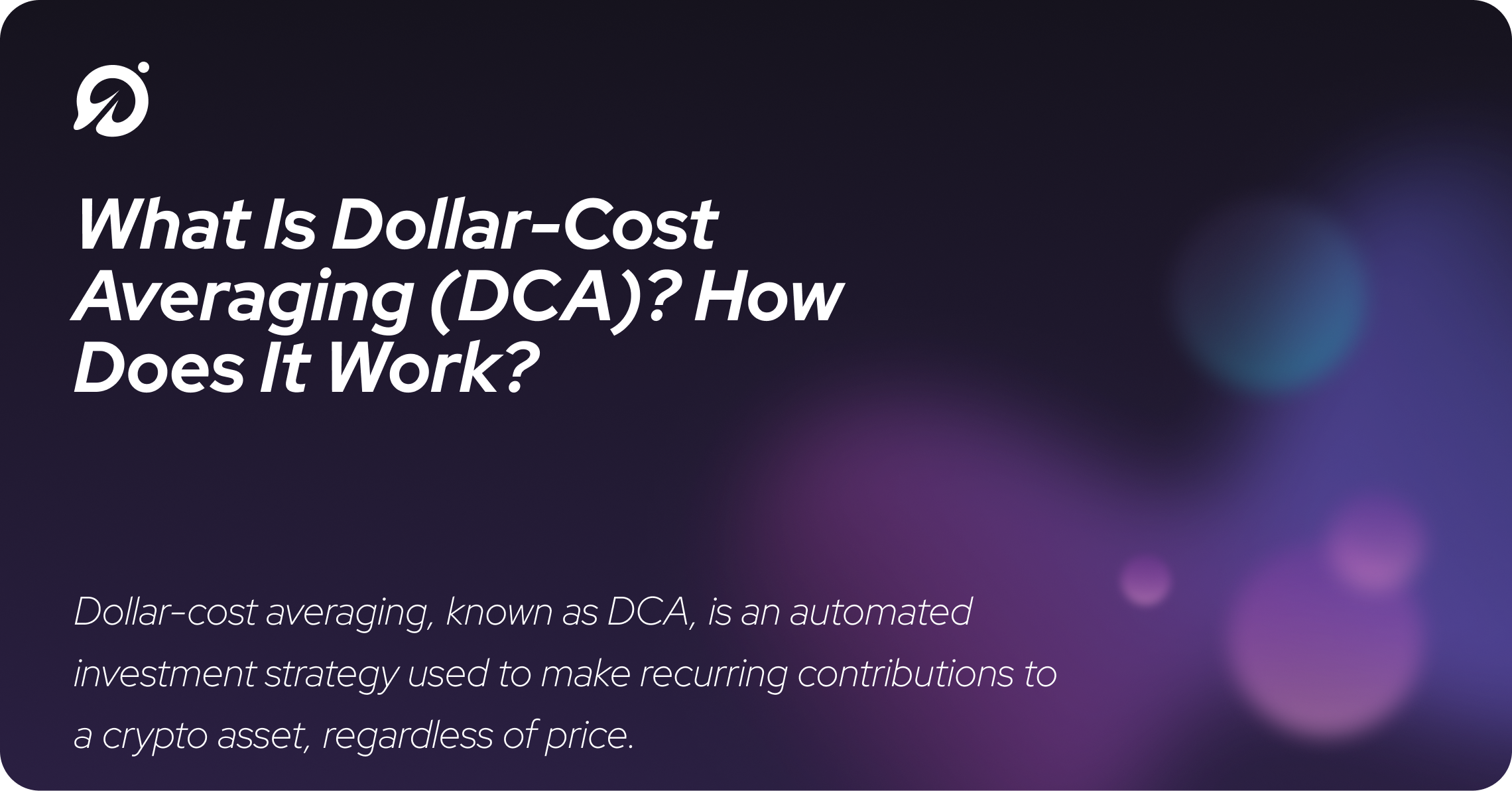What Is Dollar-Cost Averaging (DCA)? How Does It Work?
Timing the market involves strict attention to detail and a high chance of human error. Dollar-cost averaging can eliminate the risk and work even better. Read on to learn more about the dollar-cost averaging strategy and how it works.

Disclaimer: This is for informational purposes and is not meant to serve as financial or investing advice.
What Is Dollar-Cost Averaging (DCA)?
Also known as the constant dollar plan, dollar-cost averaging is a tool that investors can use to combat price volatility in any market, including the stock market and the crypto market.
Dollar-cost averaging is an investment strategy, called the DCA strategy, that makes scheduled and automated investments in smaller amounts into a target asset regardless of asset prices.
This strategy allows stock and crypto investors to invest regularly with recurring buys by spreading out purchases so that the total price paid for an asset is less affected by market timing and removes short-term price speculation. DCA also lowers the average cost per share of investment.
By investing regularly in fluctuating markets like the stock market or crypto market, investors will buy more shares at lower prices and fewer shares at higher prices.
How Does DCA Work?
DCA is a wealth-building investment plan used by investors to make regular fixed amounts of contributions toward saving for the future as long-term investments.
It is also a way for investors to ignore short-term volatility in the market by investing in regular intervals. DCA is one of the best strategies for beginner investors looking to trade ETFs.
An excellent example of the dollar-cost averaging strategy at work is 401k plans, where employees designate a portion of each paycheck into retirement, regardless of the investment price.
A 401k plan is designed as a retirement account. Employee recurring deductions come from gross income, meaning that the money comes from an employee’s payroll before income taxes are deducted and is then invested.
You can also use dollar-cost averaging outside of 401k plans to save for retirement, like Roth IRA and traditional IRA plans, and regularly invest in a taxable brokerage account in mutual funds or index funds.
For the crypto market, the DCA strategy works similarly to the stock market.
A select amount of cryptocurrency exchanges allow investors to implement the DCA strategy and provide the option to take part in their commercial DCA bots.
For example, a monthly DCA into Bitcoin (BTC) or Ethereum (ETH) can resemble this:
- Decide on a set amount of money, say $200 or 200 USD.
- Every month, once your paycheck arrives, deposit $200 into a crypto exchange.
- Once the deposit is cleared, you can buy 200 USD worth of Bitcoin or Ethereum, regardless of their asset price point.
Or, you can automate your dollar-cost averaging strategy. The point is that DCA works by sending regularly scheduled amounts of money toward an asset.
What Are the Benefits of Dollar-Cost Averaging?
There are many benefits of DCA, including the following:
Lower Average Cost of Investments
Dollar-cost averaging can lower the average cost of investments over time. Making recurring purchases of the same stock or digital asset regardless of market prices will eventually average out, bypassing fluctuations in the financial markets.
Investors will buy more shares at lower prices and fewer at higher prices, making the overall average cost lower.
Removes Aspects of Human Error
Using the dollar-cost averaging strategy removes aspects of human error and emotion when trying to “time the market.” Acting on your feelings can lead to the potential of damaging your stock or crypto portfolio.
For beginners who need more experience trading stocks daily or identifying trends in the market, DCA is the ideal strategy for you. Knowing when to enter a trade or exit is a practiced skill and can involve much human error if not executed precisely.
Instead, DCA enables discipline, looking away from purchase prices and focusing on the bigger picture to build wealth over time.
Regular Investments
As history has proven, regular investments, no matter the investment amount, will contribute to wealth building in the long term. This automatic strategy takes the concerns about when to invest out of your hands altogether.
Oriented Toward Long-Term Growth
As mentioned, DCA is oriented toward long-term growth over time, not short-term gain. This investment plan sustains through downturns in the market and focuses on the total investment.
DCA FAQs
1. How Does DCA Work in Crypto?
For crypto investors, buying in the dip sounds much easier than it is. Trying to time the volatile crypto market requires practice and skill; even then, it is complex and unpredictable.
DCA works for both new and seasoned crypto investors in the same way in crypto as in the stock exchange.
When dollar-cost averaging in crypto, the most important thing is to pick a DCA investment of your choice, make recurring contributions, and stick with it. In doing this, you have ensured the average price of a digital asset over time will withstand market fluctuations.
2. Is DCA Better Than HODL?
Ultimately, if your goal is to obtain more crypto, then in the long run, regularly doing DCA will outlast HODL.
The HODL strategy is an acronym for “hold on for dear life.” This strategy is the traditional crypto investing method: buying and holding. This strategy is commonly used to combat market volatility and involves holding onto crypto assets without selling for an extended period.
DCA has proven to outlast HODL because, with DCA, you are consistently putting additional money into your digital asset position. When you do the math, the additions add up over the years. Adding money may keep you in a long-term bullish market.
3. What Is the Best Time To DCA?
Many investors and traders have tried to “time the market.” As we know, there is no best time for the market, especially the crypto one.
DCA is a preferred strategy in the crypto world because there is no downtime on available funds and when to use them. With DCA, funds are actively used regardless of a bull or bear market.
For DCA to work at its total capacity, you must automate your purchases. End of story.
How Can You Start Dollar-Cost Averaging?
Many crypto platforms and exchanges have the option for you to start dollar-cost averaging on your investments.
DCA for crypto step by step is as follows:
- Choose your DCA frequency: Some examples of frequency intervals are weekly, monthly, or quarterly.
- Set up your buy order: There are a few ways of buying orders to choose from, including:
- Manually purchasing cryptocurrencies on preselected dates and frequency.
- Set up automated buy orders for cryptocurrencies on your crypto exchange.
- Use a bot system to make automated DCA purchases.
For the most passive, hands-off approach to DCA investing, using a bot for an annual fee has gained popularity in the crypto world. Automating or using a bot rather than manually purchasing your cryptocurrencies removes human error and emotion from your investment journey.
What Are Some Drawbacks of Dollar-Cost Averaging?
Although DCA has many benefits for new and experienced investors, every method has drawbacks.
One of the significant potential drawbacks is purchasing a digital asset while the price is exceptionally high.
DCA is not immune to purchasing securities when the price is unrealistic; it is designed to make recurring purchases regardless of timing and price action. Therefore, you may see buys at very high prices.
Some other drawbacks of the dollar-cost averaging strategy include the following:
- Not meant for short-term investments. As DCA is a long-term strategy, there are better options for short-term investments. DCA does not time the market, so its entry and exit points are not considered when long-term investing.
- Lower short-term rewards compared to spot trading: In a bull market, DCA can encourage purchases of higher asset prices. For traders interested in spot trading, skill is necessary to know when to pull out of a move. Spot traders can see greater returns when practicing spot trading rather than DCA.
- Higher purchase fees: As one of the most significant downsides to DCA, seeing purchases at higher prices is inevitable due to regularly scheduled orders. As mentioned above, even at higher purchase fees, DCA will even out the average cost of investments when prices drop and more money is allotted to lower-priced assets.
The Bottom Line
Dollar-cost averaging is not a foolproof method, but it is a proven strategy that works for long-term investors who wish to build wealth over time.
This strategy has some drawbacks, but the benefits outweigh the cons. Consider dollar-cost averaging if you want a hands-off, disciplined approach to investing for your future.
For more information on automated investing and where to start, visit Pluto today.
Sources:
Dollar-Cost Averaging (DCA) Explained With Examples and Considerations | Investopedia
What Is a 401(k) and How Does It Work? | Investopedia
Crypto DCA: Complete Crypto DCA Strategy & Tools Guide (Updated) | AltcoinTrading.NET
